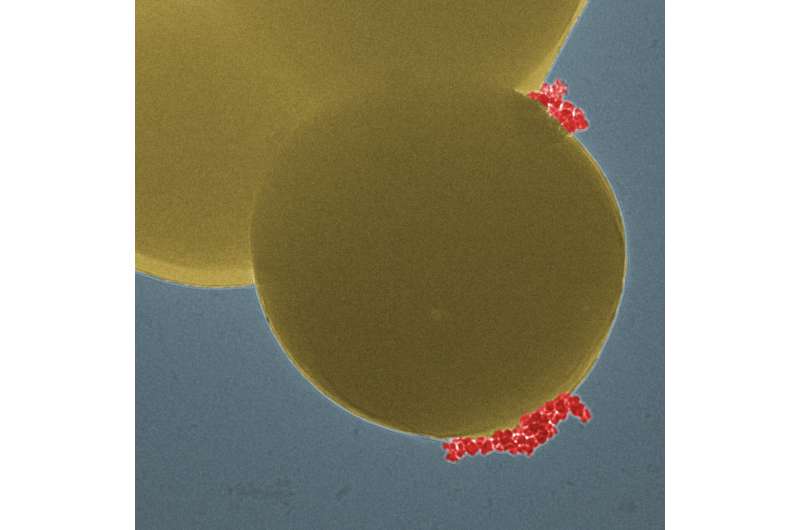
Qun Ren, an Empa researcher, and her team are currently developing a diagnostic procedure that can rapidly detect life-threatening blood poisoning caused by staphylococcus bacteria.
Staphylococcal sepsis is fatal in up to 40% of the cases. An infection with the spherical bacteria may have started as a local skin disease or pneumonia. Once the staphylococci have swarmed into the bloodstream in the course of sepsis, severe complications can arise. In such situations the pathogens must be identified as quickly as possible and appropriate antibiotics selected for treatment.
This is particularly crucial for the survival chances of those affected, as Staphylococcus aureus strains can be insensitive to various antibiotics. “If the bacteria in a blood sample first have to be cultivated for a diagnostic procedure, valuable time is lost,” explains Qun Ren, the group leader from Empa’s Biointerfaces lab in St. Gallen. Qun Ren and her team colleague Fei Pan therefore looked together with researchers from ETH Zurich for a way to bypass the lengthy intermediate step.
The team has developed a method using magnetic nanoparticles that can bind to staphylococci. The bacteria can thus be specifically detected via a magnetic field. In a next step, the sensitivity to antibiotics is analyzed using a chemiluminescence method. If resistant bacteria are in the test tube, the sample emits light. If, on the other hand, the germs can be killed with antibiotics, the reaction vessel remains dark. “All in all, the sepsis test takes around three hours—compared to several days for a classic cultivation of bacterial cultures,” says Fei Pan.
Another unpleasant representative from the bacterial kingdom is Pseudomonas aeruginosa. This rod-shaped bacterium can cause various diseases, including infections of the urinary tract, for example, via a urinary catheter during a hospital stay. Such infections can subsequently develop into sepsis. And these pathogens are also often resistant to a number of antibiotics.
This is where another advantage of the magnetic nanoparticles comes into play: The method can be tailored to many different types of bacteria, similar to a modular system. In this way, Empa researchers were able to develop a rapid “sepsis sensor” based on magnetic nanoparticles. In samples containing artificial urine, the method reliably identified the bacterial species and determined possible resistance to antibiotics via a chemiluminescence reaction.
So far, the researchers have evaluated their magnetic nanoparticle kit for sepsis and urinary tract infections using laboratory samples. “In a next step, we would like to validate the sepsis tests together with our clinical partners by evaluating patient samples,” says Qun Ren.
The research is published in the journals ACS Sensors and Biosensors and Bioelectronics.
Worldwide, the declining effectiveness of antibiotics causes more than one million deaths each year. For example, some staphylococci can no longer be controlled with common antibiotics because they have developed resistance. The proportion of multi-resistant pathogens is particularly worrying. Already, the worldwide antibiotic resistance of pathogens is being described as a “silent pandemic.” When diagnosing an infection, the speed and precision, with which a germ is identified, can be critical for the survival of those infected.
More information:
Fei Pan et al, Ultrafast Determination of Antimicrobial Resistant Staphylococcus aureus Specifically Captured by Functionalized Magnetic Nanoclusters, ACS Sensors (2022). DOI: 10.1021/acssensors.2c01837
Fei Pan et al, Specific capture of Pseudomonas aeruginosa for rapid detection of antimicrobial resistance in urinary tract infections, Biosensors and Bioelectronics (2022). DOI: 10.1016/j.bios.2022.114962
Journal information:ACS Sensors
,
Biosensors and Bioelectronics
Provided by
Swiss Federal Laboratories for Materials Science and Technology

READ MORE
New COVID-19 rapid-test technology performs PCR faster than similar tests on the market
Infrared heating of plasmonic nanoparticles facilitates multiplexed reverse transcriptase quantitative PCR for rapid detection of [...]
Trapping tiny particles: A versatile tool for nanomanipulation
Using a metamaterial, the group traps nanoparticles. Credit: Okinawa Institute of Science and Technology At [...]
Neither a Tightwad Nor a Spendthrift Be
Feedloader (Clickability) The difference between a spendthrift and a tightwad comes down to emotional pain, [...]
Fecal Fermentation and Electronic Pills May Help Decipher Gut Gases
An ecosystem of bacteria lives in our intestines and produces gases. Detecting these gases in [...]
Is It Possible to Increase the Towing Capacity of a Truck?
Manufacturers build cars and trucks to meet specific towing capacities. Tsolo/Getty Images You’ve been saving [...]
Changing a 2D material’s symmetry can unlock its promise
Deforming MoS2 leads to the observation of the flexo-photovoltaic effect. Credit: Jie Jiang, Jian Shi [...]
How to Calculate Net Operating Loss
A bad business year is rough to weather, but if you operated at a loss, [...]
December 22 Birthday Astrology
The astrological symbol for Capricorn, the tenth sign of the year, is the Sea-goat. Numerology [...]